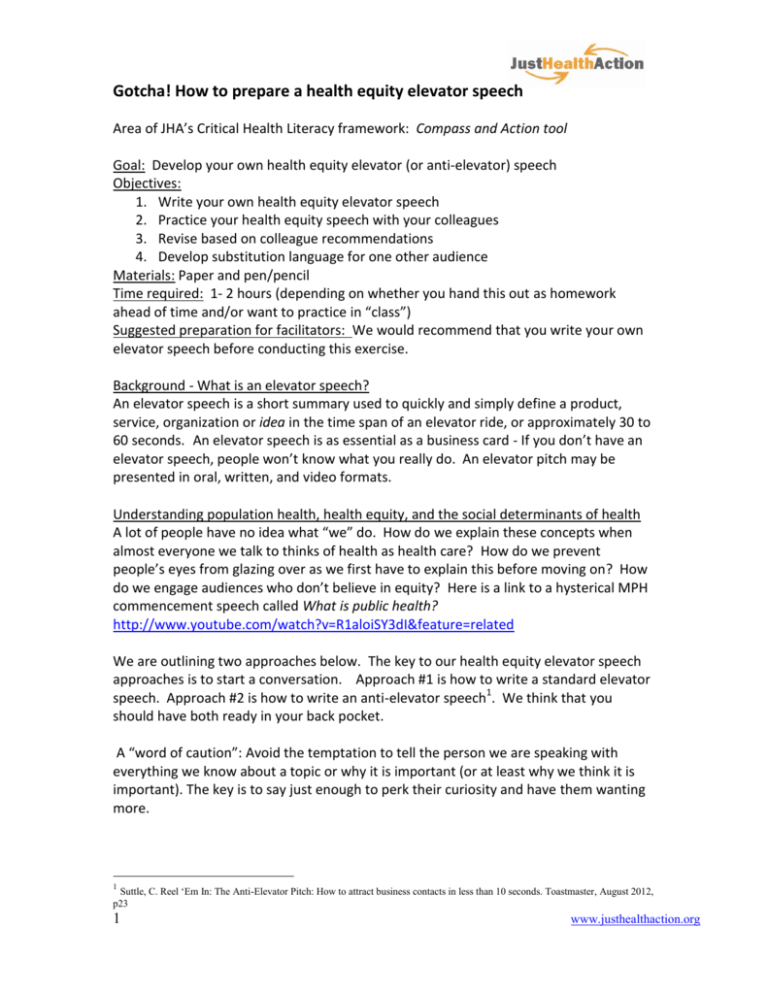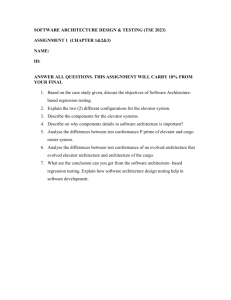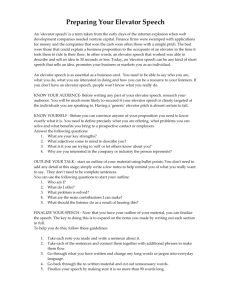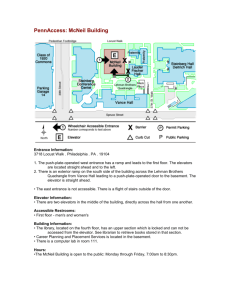Health Equity Elevator Speech
advertisement

Gotcha! How to prepare a health equity elevator speech Area of JHA’s Critical Health Literacy framework: Compass and Action tool Goal: Develop your own health equity elevator (or anti-elevator) speech Objectives: 1. Write your own health equity elevator speech 2. Practice your health equity speech with your colleagues 3. Revise based on colleague recommendations 4. Develop substitution language for one other audience Materials: Paper and pen/pencil Time required: 1- 2 hours (depending on whether you hand this out as homework ahead of time and/or want to practice in “class”) Suggested preparation for facilitators: We would recommend that you write your own elevator speech before conducting this exercise. Background - What is an elevator speech? An elevator speech is a short summary used to quickly and simply define a product, service, organization or idea in the time span of an elevator ride, or approximately 30 to 60 seconds. An elevator speech is as essential as a business card - If you don’t have an elevator speech, people won’t know what you really do. An elevator pitch may be presented in oral, written, and video formats. Understanding population health, health equity, and the social determinants of health A lot of people have no idea what “we” do. How do we explain these concepts when almost everyone we talk to thinks of health as health care? How do we prevent people’s eyes from glazing over as we first have to explain this before moving on? How do we engage audiences who don’t believe in equity? Here is a link to a hysterical MPH commencement speech called What is public health? http://www.youtube.com/watch?v=R1aloiSY3dI&feature=related We are outlining two approaches below. The key to our health equity elevator speech approaches is to start a conversation. Approach #1 is how to write a standard elevator speech. Approach #2 is how to write an anti-elevator speech1. We think that you should have both ready in your back pocket. A “word of caution”: Avoid the temptation to tell the person we are speaking with everything we know about a topic or why it is important (or at least why we think it is important). The key is to say just enough to perk their curiosity and have them wanting more. 1 Suttle, C. Reel ‘Em In: The Anti-Elevator Pitch: How to attract business contacts in less than 10 seconds. Toastmaster, August 2012, p23 1 www.justhealthaction.org Approach #1: Standard elevator speech a. Who is your audience? Before writing any part of your elevator speech, you need to know your audience. Generic elevator speeches don’t work. For health equity speeches, your pitch will be different for conservatives/liberals, decision makers, data wonks, youth groups, your parents, your friends, etc. Before you start on your speech, answer the following questions: a) What kind of people make up my audience – age, gender, etc.? b) What values and beliefs drive or motivates my audience? c) How does my audience view problems? d) What solutions does my audience use to solve problems? The more information you have about your audience, the more you will be able to focus on how to engage them. The key to a successful elevator speech is to engage the audience in 30-60 seconds. b. Outline Your Talk Make an outline of the answers to the above questions. You don’t need to add any detail at this stage; simply write a few notes to help remind you of what you really want to say. They don’t need to be complete sentences. You can use the following questions to start your outline: a) Who am I? b) What do I do or what do I want to convey? c) What problem am I solving? d) What are the main contributions I am making? e) Call to action - What do you want the listener/audience do as a result of hearing my elevator speech? By answering these questions you will be able to build up a set of notes that put your material in the right order. c. Write your health equity speech Now that you have your outline of your material, you can create your speech by expanding on the notes you made above. To help you do this, follow these guidelines: a) Take each note you made and write a sentence about it. b) Take each of the sentences and connect them together with additional phrases to make them flow. c) Go through what you have written and change any long words or jargon into everyday language. d) Go back through the re-written material and cut out unnecessary words. e) Read it out loud to yourself and edit. Be sure to sound passionate and make it contagious. f) Finalize your speech by making sure it is no more than 90-180 words long. A good elevator speech will be conversational and will last 30-60 seconds or less. At three words per second for normal speaking, you need 90-180 words. NOTE: 90 words is about 6 typed lines at 12 font. It’s not much. 2 www.justhealthaction.org d. Practice your elevator speech with a partner a) Find a partner and repeat your speech out loud b) Show the commitment in your voice and your words. Direct eye contact and confident body language are key. c) Get his/her feedback and try again. d) Reverse roles e. Practice in front of everyone and ask for feedback f. Discussion 1) What different audiences did you hear? 2) How were semantics used for different audiences? 3) Which words/sentences seemed most effective? 4) How would you test these? After this session g. Perfecting your speech You need to know your elevator speech by heart. It should come to you as naturally as saying your name; it should be second nature. The only way to achieve this is by efficient and effective practice. Here are some guidelines: 1) Read the speech out loud several times. 2) Say the speech out loud in front of a mirror. 3) Get a friend/spouse/colleague to ask you for your speech and say it several times to them. 4) Use the feedback you get to modify your speech if necessary. 5) Say your (revised) speech out loud dozens of times until you know it by heart without having to think about it. 6) Show your passion and make it contagious. Show the commitment in your voice and your words. Direct eye contact and confident body language are key. h. Make versions for different audiences 1) Think about a new audience 2) What substitutions would you make to your speech? 3 www.justhealthaction.org Approach #2: Anti-elevator speech2 Curiosity killed the cat Question: What do you do? Or What are you studying? Start with a statement that attracts attention Example 1: You dream it up, we make it happen. Example 2: We excite audiences The statement has two parts: Part 1: Make a short statement that is a little confusing. (you want to avoid people jumping to conclusions – I am a plumber – where do you go from there?) Part 2: Tell people what you do but not how you do it. Include an action or feeling word (people respond to emotion – love, hate, push, drive, exhausted, stress, joy……) Gotcha 1. Come up with a saying and then be silent. Wait for: Tell me more…. or huh?.. WTF you talkin’ about? 2. Explain how you do what you do but don’t give away the plot…. Example 1: P1: What do you do? P2 (part 1): You dream it up, we make it happen. Silence………… P1: Huh? P2 (part 2): We get your computers to do what you bought them to do in the first place. P1: How do you do that?..... P2:(Gotcha…..now you can dig in…) Now it’s your turn – a. Write down a health equity anti-elevator pitch (parts 1 and 2) on an index card (template below) b. Practice your elevator speech with a partner 1. Find a partner and repeat your pitch out loud 2. Direct eye contact and confident body language are key. 3. Get his/her feedback and try again. 4. Reverse roles c. Practice in front of everyone and ask for feedback NOTE: it’s possible that these phrases might be good starting sentences for your health equity elevator speech in Approach #1. 2 Adapted from: Suttle, C. Reel ‘Em In: The Anti-Elevator Pitch: How to attract business contacts in less than 10 seconds. Toastmaster, August 2012, p23 4 www.justhealthaction.org Gotcha! - Anti-elevator practice template Person 1: What do you do? You: ______________________________________________________________ Silence………… Person1: Huh? You: ______________________________________________________________ Person 1: How do you do that?..... You: (Gotcha! – now you launch into your specific passion about health equity, population health, etc….) SEND US YOUR HEALTH EQUITY SPEECH AND/OR YOUR GOTCHA PHRASES to http://justhealthaction.org/contact/ (JHA will post these on our webpage if we get enough) Tell us: 1. Who was your audience? 2. Where did you use it? 3. How did it go? 5 www.justhealthaction.org







